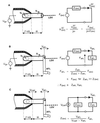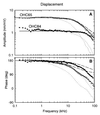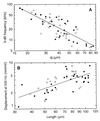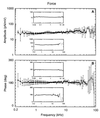Limiting dynamics of high-frequency electromechanical transduction of outer hair cells
- PMID: 10200277
- PMCID: PMC16347
- DOI: 10.1073/pnas.96.8.4420
Limiting dynamics of high-frequency electromechanical transduction of outer hair cells
Abstract
High-frequency resolution is one of the salient features of peripheral sound processing in the mammalian cochlea. The sensitivity originates in the active amplification of the travelling wave on the basilar membrane by the outer hair cells (OHCs), where electrically induced mechanical action of the OHC on a cycle-by-cycle basis is believed to be the crucial component. However, it is still unclear if this electromechanical action is sufficiently fast and can produce enough force to enhance mechanical tuning up to the highest frequencies perceived by mammals. Here we show that isolated OHCs in the microchamber configuration are able to overcome fluid forces with almost constant displacement amplitude and phase up to frequencies well above their place-frequency on the basilar membrane. The high-frequency limit of the electromotility, defined as the frequency at which the amplitude drops by 3 dB from its asymptotic low-frequency value, is inversely dependent on cell length. The frequency limit is at least 79 kHz. For frequencies up to 100 kHz, the electromotile response was specified by an overdamped (Q = 0.42) second-order resonant system. This finding suggests that the limiting factor for frequencies up to 100 kHz is not the speed of the motor but damping and inertia. The isometric force produced by the OHC was constant at least up to 50 kHz, with amplitudes as high as 53 pN/mV being observed. We conclude that the electromechanical transduction process of OHCs possesses the necessary high-frequency properties to enable amplification of the travelling wave over the entire hearing range.
Figures





Similar articles
-
High-frequency electromotile responses in the cochlea.J Acoust Soc Am. 2004 May;115(5 Pt 1):2178-84. doi: 10.1121/1.1695431. J Acoust Soc Am. 2004. PMID: 15139629
-
Fast cochlear amplification with slow outer hair cells.Hear Res. 2006 Apr;214(1-2):45-67. doi: 10.1016/j.heares.2006.01.018. Epub 2006 Apr 17. Hear Res. 2006. PMID: 16603325
-
Electromotile hearing: evidence from basilar membrane motion and otoacoustic emissions.Hear Res. 1995 Dec;92(1-2):170-7. doi: 10.1016/0378-5955(95)00216-2. Hear Res. 1995. PMID: 8647740
-
Rectifying and sluggish: Outer hair cells as regulators rather than amplifiers.Hear Res. 2022 Sep 15;423:108367. doi: 10.1016/j.heares.2021.108367. Epub 2021 Oct 2. Hear Res. 2022. PMID: 34686384 Review.
-
The Long Outer-Hair-Cell RC Time Constant: A Feature, Not a Bug, of the Mammalian Cochlea.J Assoc Res Otolaryngol. 2023 Apr;24(2):129-145. doi: 10.1007/s10162-022-00884-w. Epub 2023 Feb 1. J Assoc Res Otolaryngol. 2023. PMID: 36725778 Free PMC article. Review.
Cited by
-
Disparities in voltage-sensor charge and electromotility imply slow chloride-driven state transitions in the solute carrier SLC26a5.Proc Natl Acad Sci U S A. 2013 Mar 5;110(10):3883-8. doi: 10.1073/pnas.1218341110. Epub 2013 Feb 19. Proc Natl Acad Sci U S A. 2013. PMID: 23431177 Free PMC article.
-
Outer hair cell somatic electromotility in vivo and power transfer to the organ of Corti.Biophys J. 2012 Feb 8;102(3):388-98. doi: 10.1016/j.bpj.2011.12.040. Epub 2012 Feb 7. Biophys J. 2012. PMID: 22325260 Free PMC article.
-
High-frequency force generation in the constrained cochlear outer hair cell: a model study.J Assoc Res Otolaryngol. 2005 Dec;6(4):378-89. doi: 10.1007/s10162-005-0015-6. J Assoc Res Otolaryngol. 2005. PMID: 16237583 Free PMC article.
-
An anion antiporter model of prestin, the outer hair cell motor protein.Biophys J. 2006 Jun 1;90(11):4035-45. doi: 10.1529/biophysj.105.073254. Epub 2006 Mar 24. Biophys J. 2006. PMID: 16565043 Free PMC article.
-
Developmental expression of the outer hair cell motor prestin in the mouse.J Membr Biol. 2007 Jan;215(1):49-56. doi: 10.1007/s00232-007-9004-5. Epub 2007 Apr 6. J Membr Biol. 2007. PMID: 17415610 Free PMC article.
References
-
- Brownell W E, Bader C R, Bertrand D, de Ribaupierre Y. Science. 1985;227:194–196. - PubMed
-
- Zwicker E. Biol Cybern. 1979;35:243–250. - PubMed
-
- Hudspeth A J. Curr Opin Neurobiol. 1997;7:480–486. - PubMed
-
- Kössl M. Naturwissenschaften. 1992;79:425–427. - PubMed
-
- Santos-Sacchi J, Dilger J P. Hear Res. 1988;35:143–150. - PubMed
Publication types
MeSH terms
LinkOut - more resources
Full Text Sources
Miscellaneous

